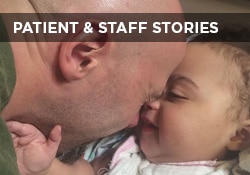This website uses cookies so that we can provide you with the best user experience possible. Cookie information is stored in your browser and performs functions such as recognising you when you return to our website and helping our team to understand which sections of the website you find most interesting and useful.

Susan E. Mazer, Ph.D. Blog
Thoughts and ideas on healthcare
Hi, and welcome to my blog! I'm Susan E. Mazer -- a knowledge expert and thought leader on how the environment of care impacts the patient experience. Topics I write about include safety, satisfaction, hospital noise, nursing, care at the bedside, and much more.
All HCAHPS Scores Being Equal: Caregiver as Patient
June 27, 2014
 “The only difference between the patient and the caregiver is acuity.” So said hospital CEO Pat Linton so many years ago. And, nothing has changed.
“The only difference between the patient and the caregiver is acuity.” So said hospital CEO Pat Linton so many years ago. And, nothing has changed.
Being human puts us at parity with each other more than we may realize. We all want pretty much the same things: respect, safety, community, comfort — and to be healthy, happy, and loved.
Then, something happens that puts us in the hospital, and regardless of who we were immediately before, our identity changes to that of “PATIENT.” This now makes us equal to all other patients, or at least with that title, we are treated like we are like all other patients.
Once we become a patient, we temporarily forget or set aside who we were prior to entering the hospital or clinic. And, once a person becomes a nurse or a physician, they become a caregiver or provider.
The result is that “PATIENT” and “CAREGIVER” forget how similar they are. This results in dispassionate treatment based on a kind of science that has also tried purposefully to forget all things human — those that are impacted by our consciousness and personality.
Objective science wants numbers rather than persons. And, even the person who reads to data must forget he or she is a person and find a kind of objectivity that can be considered absolute. This is a world that knows few absolutes.
The moment the patient and nurse start caring for each other and sharing a vital relationship, healing happens for both of them. Jean Watson’s 10 Caritas Processes begins with, “Embrace altruistic values and practice loving kindness with self and others.”
So, let’s now enter the world of HCAHPS scores and patient satisfaction that are determined by surveys and have come to own the psyche of organizations.
“Do more! Do different! Hurry! Improve! PANIC!”
Since value-based purchasing was born, every healthcare organization has been put in the position best described by these exclamatory demands. Hospitals are now on a class-curve where, as in high school, test scores are based on a comparative mean that includes all the other similar hospitals.
Every year, hospitals must measurably improve, again scored according to the comparative improvement of other similar organizations. What does this do to our organizational health?
Without question the pressure is on. And, without question, every member of the organization is feeling it. The result of continued demands coupled with few demonstrable remedies is transformation fatigue.
All of us are susceptible to learned helplessness, a sense that no matter what we do, we have little or no effect on outcomes. Given that the situation shared by both patient and caregiver is one in which they are sharing the same space (hospital room), time (admission period), and objectives (to get well enough to leave the hospital), it’s no surprise that their experiences are more symbiotic than is currently acknowledged.
What to do? First, the same consideration, concerns, and care must be offered to everyone. In fact, this is the first, second, and all other steps.
If there is not parity of worth between patients and caregivers (including everyone), learned helplessness will set in and the whole organization will become symptomatic.
These symptoms are disengagement, lack of empathy and compassion for each other, and loss of the “edge” that fuels us because we have no sense that we are making a difference or that we matter.
If patients visibly see the collaboration, respect, and camaraderie between all the members of the team that are involved in their care, it reinforces their trust in what is happening to them. The opposite is, of course, lack of trust, and often patients and family members pick up attitudes and mimic them.
Somehow, teaming up with others to face the challenge, make changes, and share accomplishments cuts through all the other pressures that are so very difficult when faced alone.
You cannot give away what you don’t have. So, start every day — at every meeting and every encounter with an appreciation for who has chosen to work in your organization, on your unit, or in your department.
Random acts of respect and caring are the first symptom of a healthy, vital, and engaged individual and organization.
P.S. If you like this post, please do me a favor and share on LinkedIn, Twitter, Facebook, etc. Also to get automatic notices when a new post is published, subscribe (upper right). No spam – just great content. Thanks!










